Have you ever tasted an egg so creamy it melts in your mouth? Silkie chicken eggs, produced by the fluffy and endearing Silkie breed, offer a unique experience for poultry enthusiasts and food lovers alike. These petite eggs, known for their delicate flavor and smooth texture, stand out in the world of poultry farming.
This comprehensive guide explores every aspect of Silkie chicken eggs, from their characteristics and nutritional benefits to raising Silkie chickens and cooking with their eggs. Whether you’re a backyard farmer, a culinary explorer, or simply curious, this article provides all the details you need to understand and appreciate these remarkable eggs.
Key Takeaways:
- Silkie chicken eggs are small, typically weighing 1.2-1.5 ounces, with white or cream-colored shells.
- They offer a creamy texture and mild flavor, perfect for gourmet dishes and baking.
- Silkie hens lay 100-120 eggs annually, fewer than high-yield breeds, but are valued for quality.
- These nutrient-dense eggs provide protein, vitamins, and minerals for a healthy diet.
- Proper housing, nutrition, and care are essential for consistent Silkie egg production.
What Are Silkie Chicken Eggs? Your Guide to These Unique Eggs:
Silkie chicken eggs come from the Silkie breed, a bird celebrated for its fluffy, fur-like feathers and docile personality. These eggs are smaller than standard chicken eggs, typically weighing between 1.2 and 1.5 ounces.
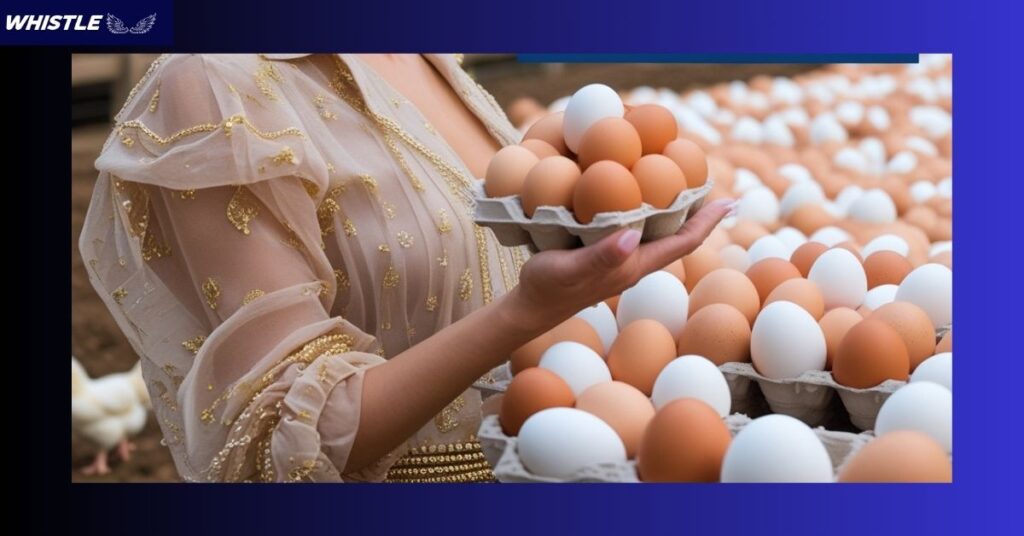
Their shells are smooth, often white or lightly tinted, and their contents boast a rich, creamy yolk. Silkie hens lay these eggs at a moderate pace. Their unique qualities, combined with the breed’s charm, make Silkie eggs a favorite among poultry keepers worldwide. Additionally, their rarity in commercial markets adds to their appeal for those seeking specialty eggs.
“The egg is a small universe, holding life’s potential in its shell.” – Anonymous
Silkie Facts Chart:
| Feature | Details |
| Egg Color | Cream to light brown |
| Egg Size | Small (35-45 grams) |
| Annual Egg Production | 100-120 eggs per year |
| Temperament | Friendly, docile, great for kids |
| Broodiness | Very high—excellent mothers |
| Skin & Bones | Black |
| Feathers | Soft, silk-like texture |
| Comb Type | Walnut-shaped |
| Flight Ability | Low—can’t fly well |
Silkie Chicken Eggs in Culture and History – Their Fascinating Legacy:
The Silkie chicken has a long history, and the eggs are culturally important in many areas. Learning about their history gives added depth to our understanding of these distinctive eggs and their lasting legacy.
Origins of the Silkie Breed:
Silkies had their origin in Asia, possibly China, more than 1,000 years ago. Their soft feathers and black skin created a sensation in ancient markets, being regularly found on trade routes such as the Silk Road. Their eggs were valued and consumed in traditional foods, which secured their place in culture. According to Marco Polo, they were described by him in his journeys, mentioning their exoticism.
Symbolism and Uses:
In certain Asian societies, Silkie eggs represent prosperity, renewal, and fertility. They’re usually incorporated into ceremonial foods, including soups or steamed custards, in wedding ceremonies or festivals. Because of their size and fragility, they represent a symbol that is well suited to symbolize attention and care, echoing the amount of work involved in breeding Silkies. Today, they’re also appreciated in farm-to-table movements due to their genuineness.
Modern Cultural Relevance:
Nowadays, Silkie eggs are being admired by sustainable farming groups and poultry hobbyists. They’re showcased on blogs, social media, and farmers’ markets, where people are drawn to their distinctive traits. Their cultural heritage lives on as farmers swap stories of how they raised these lovely birds.
You Must Know This: Wood Pigeons Lifespan – How Long Do These Birds Live?
Silkie Chicken Egg Characteristics – Size, Color, and More Revealed:
Delving into the details of Silkie chicken eggs shows their unique charm. From their size to their yolk content, these eggs have distinguishing features that make them stand out. Let’s delve into their details to learn about their worth for farmers and food lovers.
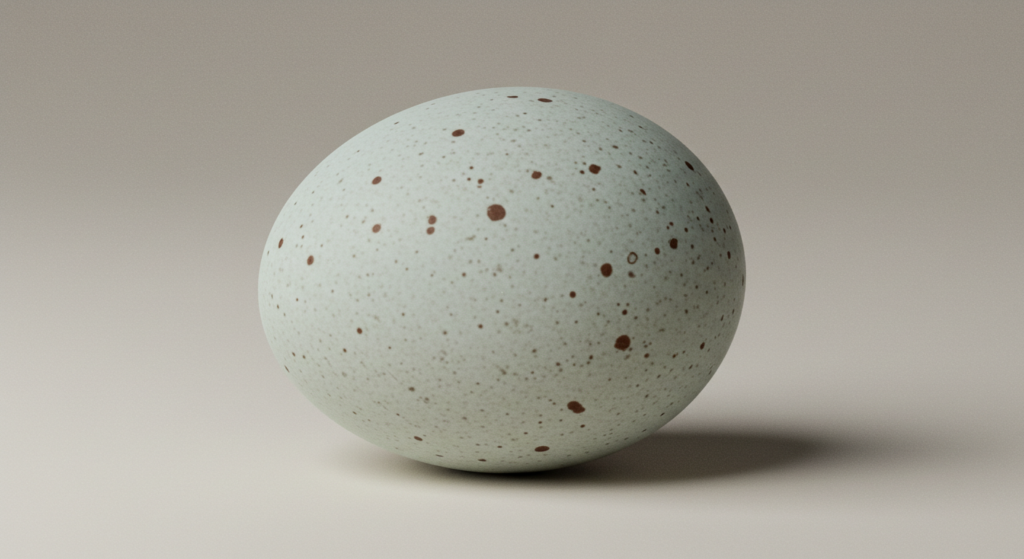
Size and Weight:
Silkie eggs are significantly smaller than regular eggs. At 1.2-1.5 ounces, they are in the small or peewee range by poultry industry standards. Their small size is perfect for single servings, children’s portions, or recipes that need exact measurements. For instance, one Silkie egg is ideal for a mini frittata or a light custard. In spite of their diminutive size, they pack strong flavor and nutrition and will attract health-minded consumers.
Shell Color and Texture:
Silkie eggs usually have white or cream-colored shells, although their might be weakly tinted with pink or beige based on diet and genes in the hen. The eggshell is thin and smooth compared to larger bird varieties but nonetheless deserves careful touch due to thinner thickness. They fit well to decorate the outward look of eggs as a great delight for the buyer or decorator and are sold for farm use, market decor, or other specialty purposes through their collection without spoiling due to fragility.
Yolk and White Proportion:
Within, Silkie eggs display a bright, creamy yolk alongside a transparent, slightly thick white. The yolk is in proportion to the white, providing meals with a rich, silky texture. The flavor is soft but slightly sweet, setting it apart from the stronger taste of other eggs. This makeup provides Silkie eggs as the number one selection in recipes such as hollandaise sauce, where smoothness is the requirement. Their consistency also complements baked goods, adding moisture and complexity.
Shell Strength and Formation:
Silkie egg shells are thin but normally formed when hens are properly nourished. Deficiencies in calcium make shells weak, which may crack or result in soft shells. Adding calcium supplements like crushed oyster shells makes the shells strong. Shell formation in the hen’s oviduct occurs in about 20 hours, with the outer shell hardening at the time of laying. Knowledge of this process makes it easier for farmers to maximize hen health to maintain quality eggs consistently.
Silkie Egg Comparison Chart:
| Breed | Egg Color | Egg Size | Annual Production |
| Silkie | Cream/light brown | Small | 100-120 |
| Leghorn | White | Large | 280-320 |
| Rhode Island Red | Brown | Large | 250-300 |
| Ameraucana | Blue | Medium | 200-250 |
Nutritional Benefits of Silkie Chicken Eggs – Best Superfood:
Silkie chicken eggs pack a surprising nutritional punch despite their small size. Their rich nutrient profile makes them a valuable addition to any diet. Let’s examine the health benefits they offer in detail to see why they’re considered a superfood.
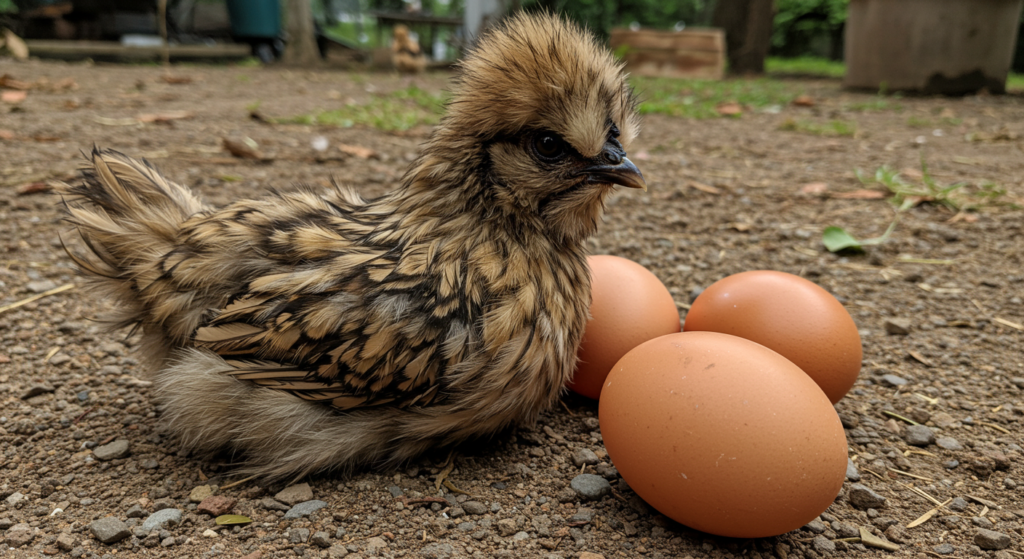
Protein Powerhouse:
Each Silkie egg provides approximately 5 grams of high-quality protein, essential for muscle repair, immune function, and energy. This protein is complete, containing all nine essential amino acids. For individuals seeking sustainable protein sources, Silkie eggs are an excellent choice. They’re particularly beneficial for vegetarians who include eggs in their diets, offering a nutrient-dense alternative to meat.
Vitamins and Minerals:
Silkie eggs are loaded with essential vitamins and minerals. Vitamin B12 supports nerve health and red blood cell production, while vitamin D aids calcium absorption for strong bones. They also contain selenium, an antioxidant that protects cells, and phosphorus, which supports bone and teeth health. Choline, abundant in the yolk, promotes brain function and liver health. These nutrients make Silkie eggs a powerhouse for overall wellness.
Low-Calorie Option:
With only 50-60 calories per egg, Silkie eggs are a low-calorie food that fits into weight-management plans. Their satisfying texture and protein content help curb hunger, reducing the need for frequent snacking. For example, a breakfast of two Silkie eggs with vegetables provides a filling, nutrient-rich meal under 150 calories. This makes them ideal for those balancing flavor and health goals.
Healthy Fats:
The yolks of Silkie eggs contain healthy fats, including omega-3 fatty acids, which support heart health and reduce inflammation. While the fat content is modest (about 4 grams per egg), it contributes to satiety and nutrient absorption. These fats are particularly beneficial when paired with vegetables, enhancing the body’s uptake of fat-soluble vitamins like A and K. Their balanced fat profile adds to their dietary appeal.
“From the egg comes nourishment, from nourishment comes life.” – Ancient Proverb
You Must Know This: Male vs Female Cardinals – 5 Key Differences Explained!
Keeping Silkies for Eggs – (Boost Egg Production with These Tips)!
Keeping Silkies for eggs can be a great experience, but special care is necessary to get them to lay the most. In contrast to commercial birds, Silkies are broody layers and tend to lay eggs seasonally, so laying can be hit-or-miss.
Silkie Laying Age:
Silkies take longer to start laying eggs than the majority of chicken breeds. Whereas most normal breeds will begin laying eggs at the age of four to five months, Silkies will not lay until seven to nine months of age. In a few cases, they may be as long as one year. This delayed maturity is a testament that the owners of Silkies have to wait patiently, but when they finally begin laying, their eggs are a delight and a rewarding experience to any flock.
Nesting Boxes:
Silkies prefer to nest in a secluded, quiet spot that provides them with some sense of security. Because they are little birds, they don’t require enormous nesting boxes, but they do prefer a cozy, well-padded area in which to place their eggs. It is generally best to provide at least one nesting box per three to four Silkie hens. Offering a quiet and secure nesting space will encourage frequent egg production and reduce stress among the flock.
Caring for Your Silkie Hens:
Good nutrition and care are responsible for maintaining your Silkie hen healthy and productive. A diet that is nutritious and high in protein and calcium is essential to good eggshell quality and continuous laying. Supplementing with eggshells or crushed oyster shells, together with good layer feed, can give a boost of calcium.
Fresh, clean water has to be constantly available to Silkies, as this influences their egg-laying and general health. They require proper lighting as well, with at least 14 hours of daylight to keep laying eggs consistently. Artificial light can be provided during winter months to ensure optimal laying conditions.
Egg laying by Silkies might slow down during winter because they have less sunlight. Provide artificial lighting to sustain 14-16 hours of light per day, promoting continuous laying throughout the year. Insulate coops to keep out cold, since Silkies dislike extreme temperatures. Shade and ventilate in the summer to prevent heat stress. Seasonal modification of care assures constant egg production.
Incubating and Hatching Silkie Eggs – The Best Hatch Rates:
Silkies are extremely broody, hence being the best natural incubators should you wish to hatch eggs. Should you decide to hatch Silkie eggs, you have two options: you can leave it to a Silkie hen to do the work of incubation or you can use an incubator.
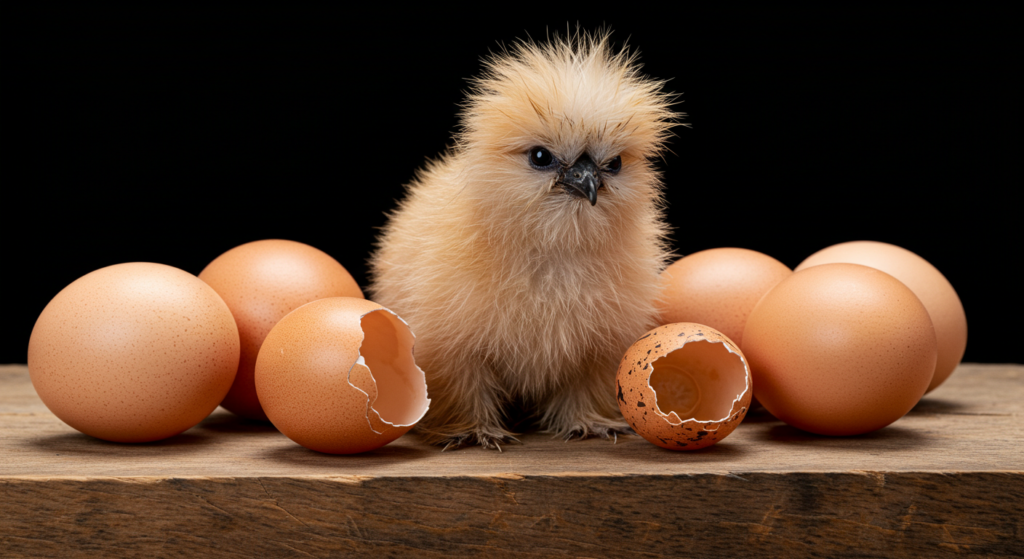
Silkie Egg Incubation Period:
Silkie eggs incubate between 19 and 21 days as well, although in some cases they will incubate a couple of days sooner than some of the bigger chicken eggs. Their incubation period is the same as all the normal chicken eggs have, only due to Silkie eggs being smaller, they may hatch from 19th day. Having good monitoring over incubating them will keep it from being a failure.
Temperature and Humidity:
Proper hatching and incubation demand that the right temperature and humidity be maintained. Silkie eggs demand a perfect incubation temperature of 99.5°F (37.5°C). Humidity is also between 45-55% until 17 days of incubation. Stepping up the humidity levels until 65-70% close to the hatching process is needed so that chicks can break through easily from eggshells.
Silkie hens are well known for their strong broody tendency, making them perfect natural incubators. It is most common for poultry farmers to prefer to allow Silkie hens to naturally incubate eggs rather than an incubator. Their dedication to remaining on their eggs and caring for their chicks makes them perfect mothers among poultry.
Cooking with Silkie Chicken Eggs – Delicious Recipes to Try:
Silkie eggs are a gem in the kitchen because of their creamy texture and delicate flavor. They are small enough to be used in a variety of dishes, ranging from breakfast to desserts. Let’s see how to utilize them in cooking and baking with innovative ideas.
Breakfast Delights:
Scramble Silkie eggs with fresh herbs such as chives or parsley for a light, fluffy breakfast. Their rich yolks provide a velvety texture that complements toast or avocado. Alternatively, prepare mini omelets with cheese and vegetables, ideal for children or fast meals. Their delicate flavor elevates simple dishes, making mornings special.
Baking Magic:
In cake recipes, Silkie eggs perform well in custards, soufflés, or sponge cakes. The smaller size means adjustments must be made—substitute three Silkie eggs for two regular eggs in most recipes. The rich yolks contribute moisture and richness to cakes and pastries. Use them in a traditional lemon curd for a silky, tangy dessert that showcases their excellence.
Creative Recipes:
Try Silkie eggs in innovative recipes such as egg tarts or small quiches. Their silky texture pairs well with rich fillings, providing an opulent mouthfeel. They also have selenium, an antioxidant that guards cells, and phosphorus, which maintains bone and tooth health. Choline, found in large quantities in the yolk, enhances brain activity and liver function. These elements make Silkie eggs a force for overall wellness.
Storage Tips for Cooking:
For best results, cook Silkie eggs within two weeks of harvest when using fresh ones. Keep them refrigerated at 40°F to preserve quality. Crack gently to prevent breaking the yolk, as their thinner shell is fragile. That way, your meals will have the optimal flavor and texture.
Silkie Chicken Egg Production Challenges – Overcoming Them:
Although Silkie eggs are rewarding, egg production has challenges. These challenges are better understood to enable farmers to manage expectations and enhance results. Let’s consider the primary challenges and solutions.
Decreased Egg Yield:
Silkie hens produce fewer eggs than high-producing breeds, about 100-120 per year. The reduced output may not be ideal for commercial settings but is appealing to hobbyists. To achieve maximum output. Embracing their moderate output as part of their attraction allows having realistic expectations.
Broodiness Tendencies:
Silkies are notoriously broody, and they will often stop laying eggs to sit on eggs. This can cause weeks of production loss. To prevent this, remove eggs daily and give a cool, well-lighted coop. If a hen is still broody, gently move her to another area for a few days. These actions reduce interruptions without stressing the hen.
Fragile Shells:
Silkie eggs have thinner shells and are likely to crack. Provide hens with plenty of calcium through oyster shell supplements. Utilize padded nesting boxes lined with soft materials such as straw to pad eggs. Treat eggs gently while collecting, handling them in a soft basket. These steps minimize breakage and egg quality.
Environmental Sensitivity:
Silkies are sensitive to extreme weather, and this can impact egg production. Cold winter or hot summer weather can stress hens, causing a decrease in laying. Insulate coops during winter and shade and ventilate during summer. Watch for signs of stress, like decreased appetite, and correct conditions quickly. A stable environment ensures consistent production.
You Must Know This: Discover 15 Charming Small Birds with Red Heads!es Explained!
Tips for Silkie Chicken Egg Collection and Storage – Keep Them Fresh:
Accurate collection and storage preserve Silkie eggs in a fresh and healthy state. Silkie eggs are fragile and need delicate care to keep them of good quality. Here are useful tips to preserve their freshness and viability.
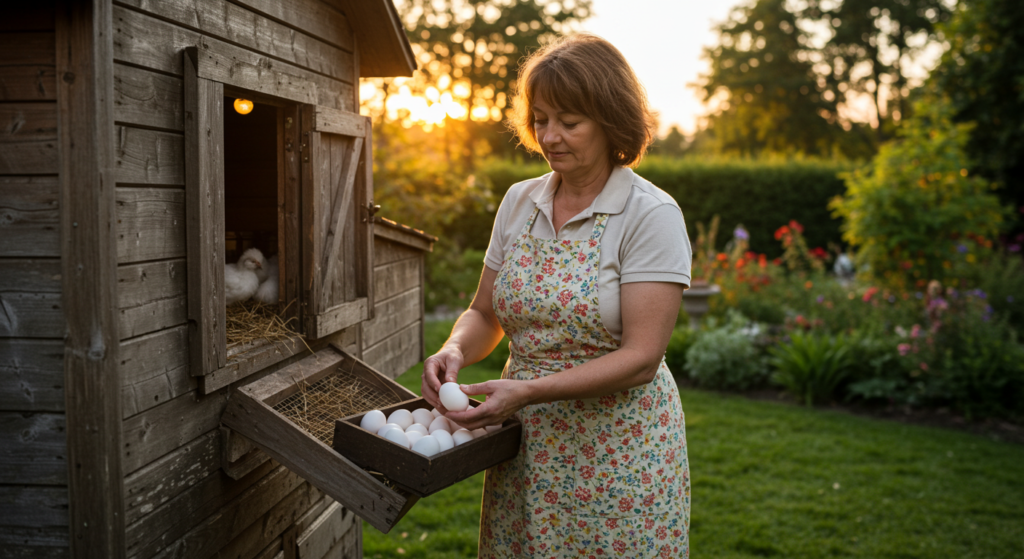
Daily Collection:
Collect eggs every day to avoid breakage or spoilage. Inspect nesting boxes early in the morning, as Silkies tend to lay early. Gently lift eggs into a soft basket or padded container to prevent cracking their fragile shells. Daily collection dissuades broodiness and keeps hens intent on egg-laying. It also helps keep eggs fresh and clean.
Cleaning and Storage:
Gently wash clean eggs with warm, soapy water if dirty, but do not wash unless absolutely necessary to retain the natural membrane of the shell. Dry carefully to avoid bacterial development. Keep eggs stored in a cool, humid environment, preferably 50-55°F, or in a refrigerator set at 40°F for extended storage. Store eggs pointed end down to ensure yolk centering and longevity.
Shelf Life and Testing:
Store freshly laid Silkie eggs for approximately one month. Place dates of collection on cartons to monitor freshness. To check for freshness, submerge an egg in a bowl of water; fresh eggs will sink but older eggs will float. Utilize older eggs first for baking or cooking to appreciate their full nutritional value and flavor.
Packaging for Sale:
If. selling Silkie eggs, ship them in clean, durable cartons to. safeguard their delicate shells. Label cartons with dates of collection and handling to establish consumer confidence. Advertise their specialty status to. defend premium prices. Accredit their. marketing appeal and secure safe transport with proper packaging.
Where to buy Silkie chickens near me In USA?
If you’re looking to purchase Silkie chickens in the United States, several reputable hatcheries and breeders offer these unique birds:
- Cackle Hatchery: Offers Silkie bantams in various colors, including black, blue, and white. Their Silkies come from show-quality bloodlines bred to APA and ABA standards.
- Valley Hatchery: Provides Silkie chicks in white, black, buff, blue, and splash varieties. They emphasize the unique charm of each color variant.
- Meyer Hatchery: Offers popular Silkie bantams in various colors, with options for sexed female-only chicks. These friendly chickens are suitable for pets or show purposes.
- Freedom Ranger Hatchery: Specializes in white Silkie bantams bred for size rather than show, ensuring a more substantial meat yield. They note that their Silkies have a sweet temperament, adding variety and entertainment to any backyard flock.
- Backyard Chickens: Offers both DNA-sexed and straight-run Silkies in various colors, including splash, buff, blue, and black. DNA-sexed chicks are guaranteed to be female and are available from four weeks of age.
- Serenity Sprouts: Provides Silkie chicks in colors such as white, black, blue, and red, with prices starting from $12.00.
FAQs:
How frequently do Silkie chickens produce eggs?
Silkies lay seasonally and more intensively in the spring and summer. Frequent broodiness can depress egg-laying.
What is Origin of Silkie chickens?
Silkie chickens originated in China and have been famous for centuries due to their distinctive appearance and friendly nature. They were introduced to the Western world by trade routes like the Silk Road and have now become a sought-after breed among poultry enthusiasts worldwide.
Are Silkie chicken eggs edible?
Yes, Silkie chicken eggs are completely consumable and are highly valued for their rich, deep flavor. While they are smaller than most chicken eggs, they offer a rich feel and less cholesterol, and thus they can be a fantastic healthy choice for a variety of diverse purposes within the kitchen.
How much do Silkie chickens cost?
The price of Silkie chickens in the USA varies based on factors such as age, color, quality, and breeder reputation: Chicks: Prices typically range from $5 to $15 each. Juveniles (5-8 weeks old): These can cost between $30 to $40, depending on quality and location. Adults: Prices range from $40 to $65 per hen, with show-quality birds potentially costing more.
What Color Eggs Do Silkie Hens Lay? (Not Black!)
Silkie eggs are typically cream or light brown, sometimes with a pinkish tint. Myth Busted: Although Silkies have black skin and bones, they DO NOT lay black eggs. If you prefer eggs that are a colorful hue, Easter Eggers or Ameraucanas might be a better choice.
Conclusion:
Silkie chicken eggs are a wonderful combination of beauty, taste, and nutrition. Their miniature size, buttery texture, and subtle flavor make them popular for cooking, baking, and health eating. Though Silkie hens are not prolific layers, the quality of their eggs and the amiable disposition of the breed make them well worth it.
By learning about their traits, nutritional value, and health requirements, you can better enjoy these special eggs. Whether you’re a farmer, food enthusiast, or inquisitive reader, Silkie eggs are something special for all.
Top Most Related Searches:
- Must Read: 9 Types of Falcons in Michigan (With Photos and IDs)!
- Must Read: 50 Blue Birds of North America – Images with Names!
- Must Read: 10 Things That Can Kill Your Bird!
